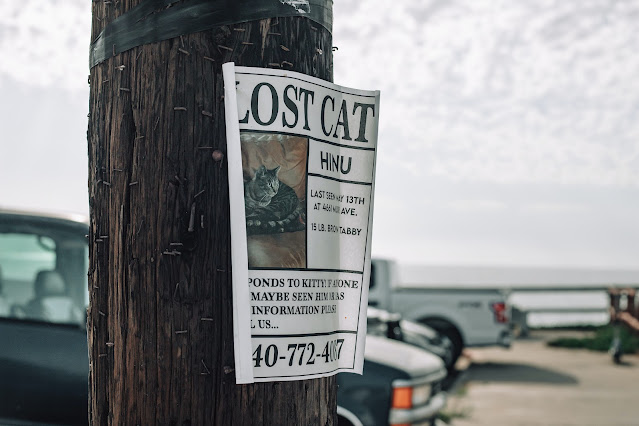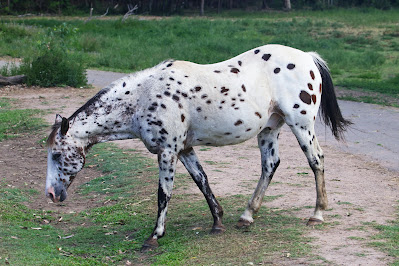Help! I Lost/Found a Pet!
According to the American Kennel Club, one in three pets will go missing in their lifetime. Losing a pet can be a scary experience! Thankfully, there are tons of resources available for finding pets, and many steps you can take to be reunited with your animal companion.

Image by Thom Gonzalez from Pexels
What to do if your pet gets lost
According to American Humane and the American Kennel Club, there are many steps you can take to recover a lost pet! The first step, as inscribed upon the cover of The Hitchhiker's Guide to the Galaxy, is Don't Panic! (It's understandable if you panic a little, but take some deep breaths, you've got this! And, we prepared a whole list of steps you can take to find your lost companion.)
First steps
- As soon as you notice that something seems off, start looking for your pet. The longer you wait, the more lost they might be getting themselves.
- Check your neighborhood or the area where they got lost. Call your pet's name or words they respond to (like toy, treat, play, walk, etc) if they are hearing animals. Bring their favorite food, treats, or toys along to help entice them. Check places they could've gotten stuck or where they could be hiding
- Let your neighbors and/or people nearby know that your pet is missing! Give them a call, swing by their house, and/or put up a post on Nextdoor and/or Facebook (or your preferred social media platform) where you know your neighbors and people nearby will see it. You can even recruit your neighbors to help you look for your pet.
 |
| Image by Andreas Lischka from Pixabay |
Next steps
- Call your local animal shelters and animal control agencies regularly (you can even call daily to check in if you don't find your pet on day 1). Consider going in person too, because sometimes it can be hard to describe your pet over the phone. You can also call the shelters and animal control agencies of nearby towns, not just your own.
- You can make "Lost" posters for your pet
 |
| Image by Varun Kulkarni from Pixabay |
- Consider placing ads in local newspapers (and consider offering a reward).
- You can let your vet/groomer know that your pet is lost, so if anyone unsure of what to do with a found animal brings them there, they can keep an eye out for you.
- Check the "found" ads, and follow up with any that look even remotely like your pet
- Call local radio stations and ask them to put out a notice for your missing animal. Some might broadcast the info for free. Try to give them lots of details here, as it's a purely auditory medium. Mention the same things you would on a poster
 |
| Image by Esi Grünhagen from Pixabay |
Online resources
- Upload a photo to Petco Love Lost
- There are other pet lost and found websites, like Petango, Pet FBI, and even Petfinder if you're having no luck with other resources, though this isn't what the latter website is strictly intended for.
- If your pet is registered with a microchip database, some, like AKC Reunite, have a "lost pet alert" that you can activate to help keep folks on the lookout for your lost animal.
 |
| Image by Daniel Frank from Pexels |
How to design an effective "LOST PET" poster
Make sure to include:
- "LOST DOG/CAT/RABBIT" at the top of the poster in big letters
- A large, recent, in-color photo of your pet
- The pet's name in large letters above the photo
- "Last seen on (DATE) at (LOCATION)"
- A written description of your pet
- Make sure to put your phone number/name on the poster, and/or another way to contact you
- Information about a reward, if you wish to provide one
- Include instructions on what to do/whether or not to approach your pet
- Make sure you keep the poster simple while providing all the relevant information
- If you can laminate/waterproof the poster in some way, that can also be quite useful
 |
| Image by Raquib Yaqubov from Pexels |
Ways to prevent pets from getting lost
If you implement the strategies below, it greatly increases the likelihood of finding your pet (and quickly), as well as helping prevent them from getting lost in the first place.
ID Tags
It's prudent to make sure your pet has a collar with tags featuring your current address and phone number so your pet can be returned to you if lost. There are also often rabies vaccination tags, which are important to leave on your pet's collar as well.
Microchipping
It's a good idea to microchip your pet, as this makes them much easier to find when they're lost. If your pet turns up in a shelter, the folks there will scan your pet for a microchip this microchip holds your contact information as well as information about your pet. If you decide to microchip your pet, it's important to register them with a database like AKC Reunite or another registry. There are many different databases for microchips to choose from.
Registration
Most towns and cities require pet owners to register their pets, which helps prove that your pet belongs to you, and can also be of use if somebody finds your pet. You can also utilize neighborhood apps like Nextdoor, which has a Pet Directory section.
Training
A well-trained animal is less likely to run off than one that has no training at all. If you can train your animal to come when called, to sit, and to stay, that can be another good prevention measure.
Regular exercise and stimulation
If your animal is getting adequate exercise, that can help make sure they don't have pent-up energy that they feel the need to express by running around and getting lost. It's also important for your pet's health to make sure your pet is mentally stimulated and not bored. For more on responsible dog ownership (many of the tips apply to pets in general), check out our article here.
Keep an eye on them
When you're out and about, especially if you take your pet to a crowded place with lots of people and they aren't used to that, make sure you keep an eye on your pet. And follow leash laws, of course. Having a fenced-in yard is an option many folks choose to allow their pets more time outside with less supervision.
 |
| Image by Anthony Rae from Pexels |
What to do if you find a lost pet
The good news is that the steps for what to do if you find a lost pet are parallel to those of what to do when you lose a pet! Instead of posting about how you lost a lizard, you post about how you found the lizard.
- First, try to capture/contain the animal as gently as possible if you can, and remain calm.
- Check to see if the animal has a physical ID tag.
- Check in with nearby people if you're in a public place, or with your neighbors if you found the pet in your own neighborhood.
- Check in with a vet or an animal shelter to get the animal scanned for a microchip, which can help locate the animal's human. Once you have the number, you can look it up yourself as well using the American Animal Hospital Association's online tool.
- Post on Nextdoor, Facebook, Petco Love Lost, Petango, and/or Pet FBI.
- You could consider making "Found" posters, which have roughly the same content as "Lost" posters but with shifted intent
- You could place a "Found" ad in your local newspaper or call into your local radio station.
- If the pet has no ID, you can also bring them to an animal shelter, as chances are, the owner will be looking at local shelters for their lost companion.
 |
| Image by Federica Castucci from Pexels |
Conclusion
Whether you've lost or found a pet, now you've got some tools you can use to navigate this tricky situation with more confidence. There are many steps you can take to get that animal companion back at home where they belong.
Countless people have dedicated plenty of time and effort to developing tools precisely for these situations, because they want pets happy and safe at home with their humans. If you need an optimism boost, many of the above-mentioned pet-finding websites have positive rescue stories. Some pets are found in hours, while others have been found even years later.
Make sure you act quickly when you lose/find a pet to ensure the greatest chance of getting them home safely.
Good luck out there!



Comments
Post a Comment